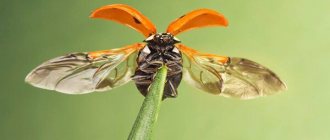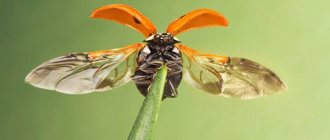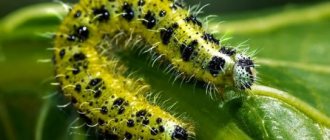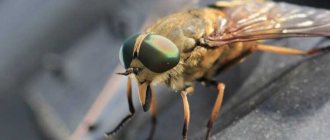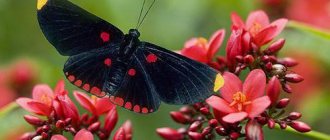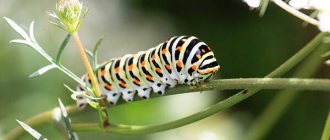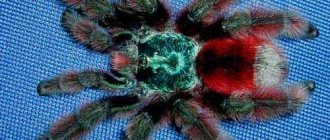We all know the basics of the food chain: plants get nutrients from sunlight, animals eat plants, and carnivorous animals eat other animals. However, even in this case, there are exceptions to the rule: there are predator plants that attract animals into a trap and then eat them (mostly insects, but snails, lizards, or even small mammals can also become victims). In this article, you'll learn about 10 carnivorous plants, ranging from the famous Venus flytrap to the lesser-known Darlingtonia.
Nepenthes
The main difference between tropical pitcher plants of the genus Nepenthes and other carnivorous plants is their size: the “pitcher” of this plant can reach a length of more than 30 cm, it is ideal for capturing and digesting not only insects, but also small lizards, amphibians and even mammals. (Doomed animals are attracted to the plant's sweet scent, and once they enter the jar, Nepenthes begins to digest them, a process that can take up to two months!) There are about 150 species of Nepenthes scattered around the eastern hemisphere; The pitchers of some plants are used by monkeys as drinking cups (after all, these animals are too large to end up in the wrong place in the food chain).
Suction bubble
A unique bubble trap is characteristic of a plant with the sonorous name Utricularia. It is small, the largest of the bubbles reach a centimeter or a little more. Accordingly, the prey is modest; the bladderwort feeds on tadpoles and water fleas. But the diversity and range are impressive. There are more than two hundred species, and this predator can be found almost everywhere, except perhaps the tundra or Antarctica. The technique used in hunting is also unusual. A small vacuum is generated inside the bubbles, and the flower, like a small vacuum cleaner, sucks in insects passing by along with water. This happens very quickly; the entire process from opening the trap hole to sealing it takes a few microseconds.
Darlingtonia
Darlingtonia is a rare carnivorous plant native to the cold waters of the marshes of Oregon and northern California. This is truly a diabolical plant: it not only lures insects into its jar thanks to its sweet aroma, but it has numerous false “exits” in it, which is why its doomed victims make unsuccessful attempts to escape to freedom.
Surprisingly, naturalists have yet to identify Darlingtonia's natural pollinators; It is known that a certain type of insect collects pollen from this flower and remains unharmed, but it is not yet known which one.
Where to buy flowers that eat insects
Acquiring predatory flowers is not a particular problem. They are offered in the form of shoots by amateur flower growers, and in the form of mature plants by some online floristry stores.
In the wild, namely in North America, the Venus flytrap is quite widespread. But local biologists are sounding the alarm; numerous poachers are destroying green spaces, offering plants to exotic lovers.
To stop the process of mass destruction of plants, the police mark wild Venus flytraps with eco-friendly paint; these paints glow in ultraviolet rays and the police quickly manage to identify illegally sold specimens; it is officially allowed to sell only plants from nurseries and home greenhouses.
Flowers that eat insects are not poisonous; if you wish, you can keep them in the house. Observing such plants is undoubtedly very interesting.
But when buying such a flower, you should understand that it requires special care, and in addition, problems with its nutrition may arise.
Stylidium
It is still unclear whether plants of the genus Stylidium are truly carnivorous, or simply trying to protect themselves from annoying insects. Some species are equipped with sticky hairs that capture small insects that have nothing to do with the pollination process, and their leaves secrete digestive enzymes that can slowly dissolve hapless victims. Further research is needed to determine the importance of consumed insects for the life of Stylidium.
Insidious beauty
The food for predatory flowers is mainly insects. They rarely sit down for anything, except to rest a little. Beetle bugs are also constantly looking for something to profit from, such is the fate of all living creatures on the planet. Of course, carnivorous plants could simply wait for a lucky break, but then it is unlikely that most of them would survive. Therefore, they take the initiative on the same principle as people who claim that luck is in their hands. In the absence of limbs, the predator plant uses the organs at its disposal, namely leaves and flowers. You can attract capricious insects with the aroma, color and beauty that captivates bees and butterflies with harmless daisies, poppies or daffodils, the only difference being that they should be even more seductive, at least from the point of view of insects.
Rosolist
The roseleaf grows in nutrient-poor soils along the coasts of Spain, Portugal and Morocco, so it supplements its diet with rare insects. Like many of the other carnivorous plants on this list, dewweed attracts insects thanks to its sweet aroma; its leaves contain a sticky slimy substance that prevents the victim from moving, and then with the help of digestive enzymes, the unfortunate insects are slowly dissolved and the plant receives the necessary nutrients.
Pemphigus
Plants, which are given one common name - bladderworts, feed on the rotted remains of insects and other animals.
Bladderwort (Utricularia) is a large genus of insectivorous plants in the bladderwort family (Lentibulariaceae). Four species of the genus can be found almost throughout the entire territory of Russia, except for the regions of the Far North.
Bladderworts live in bodies of water - puddles, swamps and rivers. Their thin branching stems float on the water and, by the time of flowering, shoot out erect shoots, on the tops of which flowers bloom. The plant has no roots at all and is not attached to the bottom by anything.
The “hunting” of this plant is passive. Among the thread-like leaves of the bladderwort are many small pale green vesicles the size of a pea. Each bubble is a trap for small swimming creatures. The trap is intricately designed. At one end of the bubble there is a thin stalk (petiole) - with its help the bubble is held on the stem. At the other end there is a small opening, like a mouth, surrounded by hard, bristly hairs. The hole is covered with a valve, which swings back freely at the slightest external pressure, and then lowers again and locks the passage inside the bubble.
The bladderwort plant has chosen those places where there are a lot of small animals (mosquito larvae, various water worms, tiny crustaceans, fish that have just hatched from eggs).
All these small fry love to scurry among the stems of bladderwrack, not knowing for the time being that trouble is very close. Now the water flea pushed into the “door” of the bladderwort, and then the valve lifted and let the dear guest inside. Following this, the plant immediately closes the entrance to the trap, and the prey is caught. There is no way back for the insect: after all, the valve opens from the outside to the inside of the bubble, but it does not open from the inside to the outside. The prey dies and rots inside the traps, and its decomposed remains seep through the walls of the bubbles into the body of the bladderwort.
Roridula
Native to South Africa, the roridula is a carnivorous plant, although it cannot actually digest insects captured by its sticky hairs. The plant leaves this task to the horsefly bugs of the species Pameridea roridulae, with which it has a symbiotic relationship. What does Roridula get in return? The waste from bedbugs is an excellent fertilizer.
By the way, in the Baltic region of Europe, fossils of roridula, 40 million years old, were discovered, which is evidence of a wider distribution of this species during the Cenozoic era, relative to its current range.
Where are green predators common?
The distribution range of insectivores is quite wide, and can be found in different ecosystems in which flowers can grow, from the tropics to the Arctic zone, in wetlands and deserts, and in the alpine mountain belt. They are more common in countries with warm, tropical climates.
On the territory of Russia there are:
- sundews of two types;
- water bladder Aldrovanda;
- representatives of butterworts;
- several varieties of pemphigus.
Zhiryanka
The plant got its name because of its wide leaves with an oily coating. This carnivorous plant is native to Eurasia and North, South, and Central America. Butterwort victims are immersed in sticky mucus and slowly dissolved by digestive enzymes. If the insects try to move, the leaves begin to slowly curl, while the sticky mucus dissolves the proteins of the prey.
Mechanisms and types of traps
Predatory plants, depending on their hunting organs, are divided into groups:
- with moving trapping organs, such as flycatchers and sundews;
- passively trapping, using sticky secretions on the leaves, such as butterwort, which have pitcher-shaped trapping organs, nepenthes, bladderwort
According to the classification of biologists, traps can be:
- sticky;
- sucking;
- pitcher-shaped leaves;
- closing leaves with the structure of a trap;
- traps similar to crab claws.
The relationship between the type of trap and the predator’s belonging to any family is not monitored.
Genlisey
Unlike other carnivorous plants on this list, Genlisea's diet likely consists of protozoa and other microscopic organisms, which it attracts and eats using specialized leaves that grow underground. These underground leaves are long, light-colored, and root-like in appearance, but the plant also has regular green leaves that are above ground and participate in the process of photosynthesis. Genlisea is distributed in regions of Africa, Central and South America.
Sarracenia
In the swamps of North America there grows a plant that scientists have dubbed the name “sarracenia”.
Sarracenia is a genus of plants in the Sarracenia family. Today there are 10 species, as well as several subspecies and about 100 varieties created by breeders.
This plant has very interesting leaves; With their help, Sarracenia hunts.
Each leaf looks like a bag or jug, narrowed at the top and bottom and swollen in the middle. At the hole that leads into the jug, protrudes a green leaf blade with burgundy-colored veins, reminiscent of a shell. It collects raindrops. From this vessel, rainwater penetrates into the bag and fills it approximately 1/2. There is always at least a little water in the bag, even in drought. Sarracenia leaves serve as trapping pits (or trapping pitchers) for insects - both winged and wingless.
Almost all types of sarracenia have brightly colored leaves. From a distance it’s like flowers—beautiful and elegant. Insects are captivated by this beauty, and this is so beneficial for the plant. The lower half of the leaf is bright green. At the bell it is light green and covered with a network of red veins. The dome looks especially colorful; here the leaf wall is very thin, almost transparent and completely decorated with veins. Well, how can you not covet such beauty?
Noticing sarracenia leaves from afar, insects approach them in the hope of eating something tasty. Their hopes are not in vain - the leaves have an excellent bait: inside the trapping jugs, at the very entrance, there are nectar-bearing glands. Looking into the middle of the leaf, the insect sinks deeper and deeper until it drowns in the liquid filling the jug. The drowned man rots, decomposes, and its rotten remains are absorbed by the walls of the sarracenia leaf. In its trapping pitchers you can find many small insects, and sometimes even frogs and rodents.
This exotic plant is also suitable for home keeping. In summer, it can be taken out to the balcony, where it will independently obtain food for itself, and in winter, it can be given food for fish.
Venus flytrap
The Venus flytrap is another carnivorous plant: maybe not the largest, but certainly the most famous in the Droseraceae family. It is quite small (no more than 15 cm in length) and its sticky “trap” is the size of a matchbox.
Interesting! The Venus flytrap, in order to reduce false slams caused by falling leaves and pieces of debris, has developed a unique mechanism for triggering the trap: it slams only when two different internal hairs touch each other for 20 seconds.
Insectivorous plants in the house
Carnivorous plants for the home are chosen only by the most passionate gardeners. These flowers are extremely capricious and demanding in terms of living conditions and quality of care at home. It is important to strictly comply with the requirements for lighting, humidity, and temperature. They also need to be fed regularly in a special way. As an example, the Venus flytrap is fed with captured flies and mosquitoes. Without proper nutrition, the plant simply cannot exist and will quickly die.
To grow a carnivorous houseplant, you need to spend a lot of time and effort, but lovers of carnivorous plants believe that their attractive appearance and interesting growing process are worth all the effort.
Stapelia
This is a cactus that eats flies. It has no stem, but its fuzzy flowers with spots resemble a sea creature. Another name for the plant: star cactus, large toad flower. May also be called starfish. The diameter of the flowers is about 40 cm. The smell of decaying flesh is very attractive to flies, beetles and larvae. They crawl into the central part of the plant, where they die.
On a note!
Place of growth of slipway South Africa. But the flower is often grown in Russia to decorate a stone garden or home landscape.
Feeding Dionea
It is important to understand that the Venus flytrap is a plant, not an animal, so it needs light and water more than just living creatures. If it is outdoors or on a balcony where insects can get in, you don't need to worry about feeding it. Under indoor conditions, feed the flytrap once or twice a month with an insect half the size of its trap. Ideally it should be a black fly, spider or several mosquitoes, as larger or tougher ones can be harmful. It is best to feed live food, as stagnant food can cause illness. A recently killed insect is also suitable, but you need to shake it slightly with a needle to stimulate the sensitive hairs and close the shutters.
When catching a flycatcher, care should be taken as its functioning is limited. After digesting food for some time, it loses the ability to hunt and dies. Therefore, if an inedible object gets there or a slamming occurs as a result of an accidental provocation, it will open after 24 hours, reducing its capacity by one time. Do not feed the plant meat or other foodstuffs as this will kill it.
Dionaea's rest period
The resting period is very important for the white flycatcher, which lasts from about November to February and must be strictly observed. The temperature will gradually decrease to +10 °C, but not below freezing point. If you have a balcony or veranda at home that does not freeze during frosts, you can place the plant there for the winter.
Once cold weather sets in, keep the soil slightly moist and limit watering, but the water should not be warmer or cooler than the air in the room. During this time, its time in daylight is reduced and attention is paid to the timely removal of blackened leaves. During the winter months, only a few leaves are produced with small traps.
If it is impossible to overwinter the flycatcher at home as a resting place, a refrigerator with a positive temperature of up to 5°C is sufficient. However, you should prepare the plant several weeks in advance, for example, in front of a half-open window. Just before putting it in the refrigerator, it should be sprayed with a fungicide and placed in a ventilated bag. Under these conditions, light is not required, but the substrate is moistened monthly with distilled water.
Prevention of flies
These frightening factors are a good reason to fight against unpleasant insects.
But you should understand: in order not to start a war with flies, lovers of dirt, certain preventive measures are necessary:
- maintaining cleanliness in the house at the proper level: frequent wet cleaning, timely disposal of garbage;
- lack of any food on the table;
- regular cleaning of the livestock pen (if any), watering the manure with karphos solution;
- mosquito nets on windows;
- pots of geraniums on the windowsills of the house;
- plants with a pungent odor planted on the site: tansy, lavender, wormwood, elderberry and bird cherry bushes.
Compliance with this series of rules will not only help you get rid of annoying insects, but will not force you to face such a problem as flies indoors.
Sources
- https://nzs-rst.ru/muhi/trava-otpugivayushchaya-muh.html
- https://notklop.ru/muhi/2-fakty/25-kakoj-zapah-otpugivaet-muh/
- https://kursi-floristiki.ru/sredstva/kakie-rasteniya-otpugivayut-muh.html
- https://KatalogPoleznogo.ru/dom/30-sposobov-vyivesti-muh-iz-kvartiryi-doma-dachi.html
- https://WikiParazit.ru/babochki-i-moshki/rasteniya-i-narodnye-sredstva-kotorye-otpugivayut-muh.html
- https://stroy-podskazka.ru/muha/zapahi-ne-lyubyat/
- https://antinasekom.ru/kak-borotsya-s-muhami.html
- https://nasekomye-vrediteli.ru/ot-muh-trava.html
- https://hloptarakan.ru/muhi/chto-otpugivaet-muh.html
Types of home remedies for flies
To combat flies inside a house or apartment, both folk remedies and special factory-made devices can be used.
Fly repellent
Folk remedies
There are many home remedies that repel or kill annoying dipterans. Knowing how to fight flies with folk remedies, it is not necessary to purchase industrial devices and compounds in stores. Among the folk remedies, the following are most often used:
- Plants. For example, leaves of fern and black elderberry, pelargonium, tomato tops, tansy grass, hanging in the kitchen and dining room can rid these rooms of flies quickly and safely.
- Poisonous traps with black pepper or chlorophos. Pepper is the same poison for dipterans as the known organophosphorus compound. The poisonous powder is mixed with sugar and placed on windows, refrigerators and furniture. Black pepper can also be sprinkled around the areas where they accumulate.
- Turpentine, castor oil, melting wax are substances that successfully repel flies from your home. True, people don’t like their smell either, so they are used only in rooms where people stay for a short time.
- Essential oils. The most effective oils are citronella, clove, eucalyptus, peppermint and lavender.
- Fly traps from a liter jar. In which bait (for example, sweet water) is poured and a cardboard cone is installed.
Store products
The following devices and devices are most often offered to combat flies:
- Ultrasonic fly repeller. A modern electronic device that can repel insects using high-frequency sound.
- Mosquito net. Framed or magnetic, they mechanically prevent them from entering your home from the street.
- Fly plates. Used similarly to mosquito repellent plates. Evaporating from the surface of the plate, the systemic insecticide kills adult insects.
- Sticky fly tape. An old remedy that has not lost its effectiveness. A mixture of a viscous substance and bait is applied to a thick paper tape. Having sat down on the tape, the fly cannot free itself with it and soon dies. Fly tape has one significant drawback - it is not very aesthetically pleasing and does not decorate the interior with its appearance.
- Liquid for fumigator against flies. It is used in the same way as the anti-mosquito composition - it is simply poured into the device, after which it is connected to the network.
- Insecticide sprays. An excellent choice for those who decide how to poison flies that appear in large numbers in the house. The spray is a highly effective means of killing adults. Some of them can be applied to the mosquito net and around the perimeter of the opening, since they have a long-lasting repellent effect.
Medical advice from Elena Malysheva on getting rid of flies on video:

